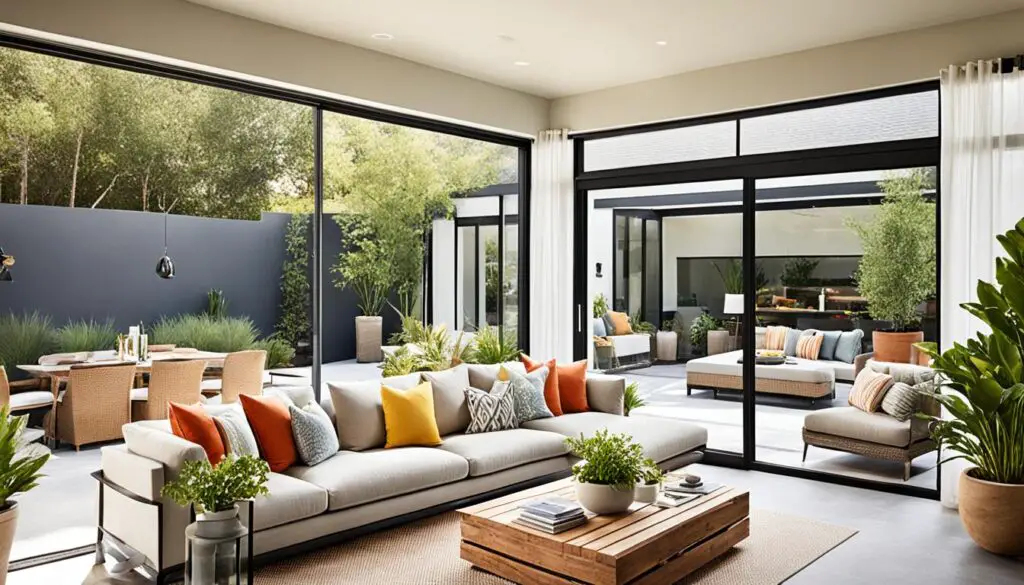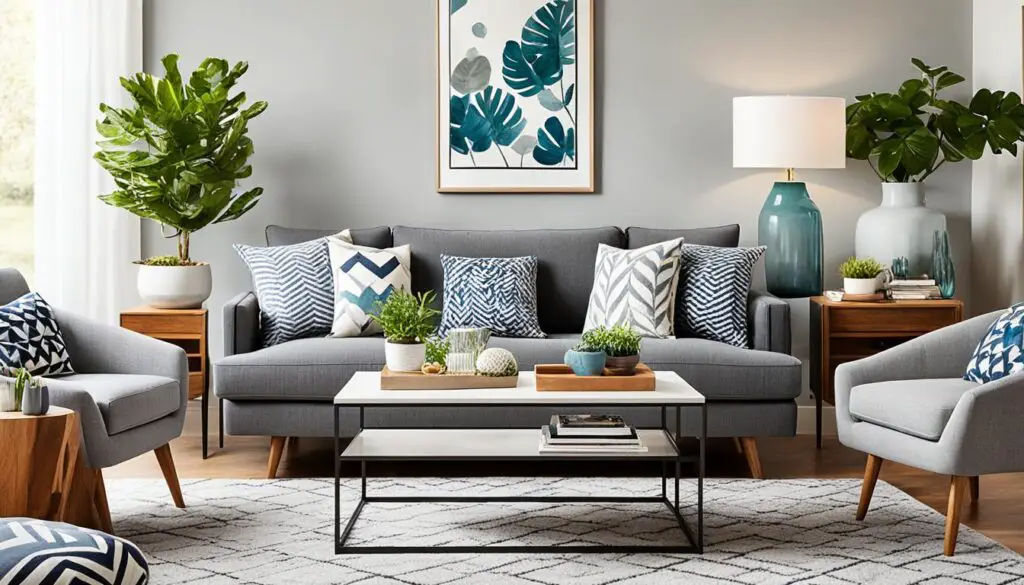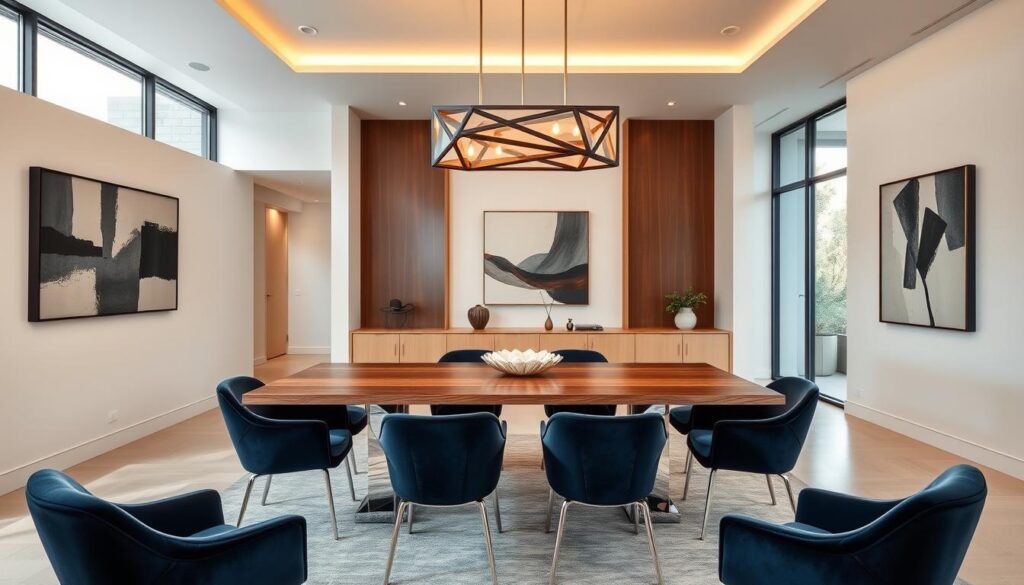
Combining living and dining areas is a growing trend in modern home decor. It’s especially popular in small spaces where every inch counts.
By merging these spaces, homeowners can make their homes feel more open and welcoming. Modern dining room decor ideas are key to achieving this harmony.
This article will explore 20 latest designs that blend living and dining spaces beautifully. It’s packed with inspiration for your next home project.
These designs range from sleek, minimalist layouts to cozy, eclectic arrangements. They show how versatile and inviting combined living and dining areas can be.
1. Trending Color Palettes for Living Rooms and Dining Areas
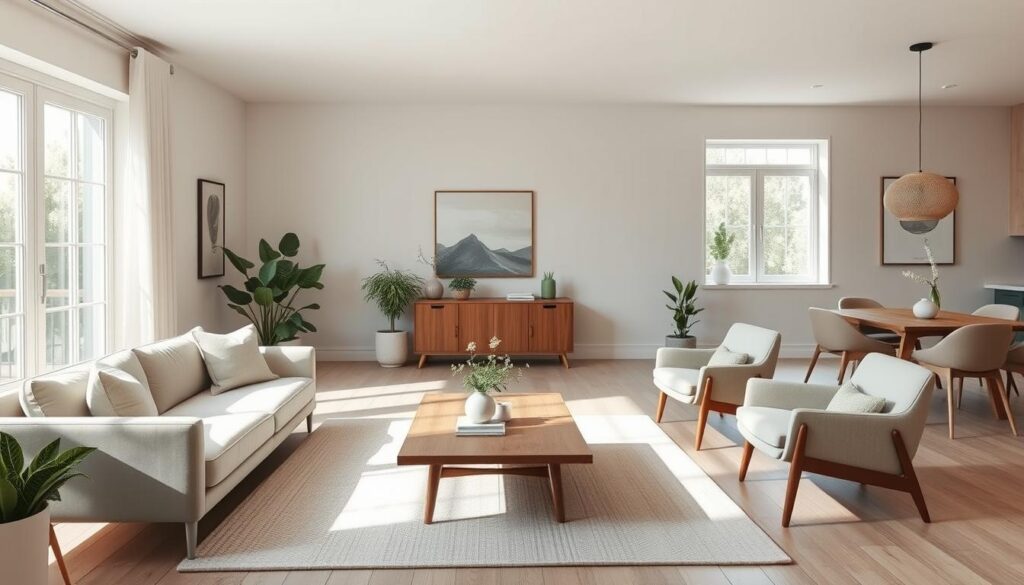
A well-designed color palette is key to a cohesive and beautiful space. The right colors can change the mood and how we see the room. They also add to the ambiance.
Choosing a color palette is about the look you want. Modern designs often mix timeless neutrals with bold colors.
Combining Neutrals with Bold Accents
One top trend is mixing neutral backgrounds with bold colors. Neutrals like beige or gray calm the space. Bold colors like navy or emerald green add personality.
This mix lets you be creative and change things up easily. Just swap out throw pillows or rugs to refresh the room.
Pastel Shades for a Calming Atmosphere
Pastel shades are back, bringing a soft, calming vibe. Colors like pale pink or mint green are perfect for relaxing spaces.
Pair pastel shades with neutrals to avoid feeling overwhelmed. This mix creates a stylish and harmonious area.
The Rise of Earthy Tones
Earthy tones like brown or sage green are becoming popular. They add warmth and coziness, making rooms feel welcoming.
To use earthy tones well, pair them with natural materials. This enhances the organic feel and ties your spaces together.
| Color Palette | Description | Ideal For |
|---|---|---|
| Neutrals with Bold Accents | Neutral background with bold color accents | Those who like to frequently update their decor |
| Pastel Shades | Soft, calming pastel colors | Creating a serene and relaxing atmosphere |
| Earthy Tones | Natural, grounding earthy colors | Bringing warmth and coziness to a room |
2. Open-Concept Living and Dining Spaces
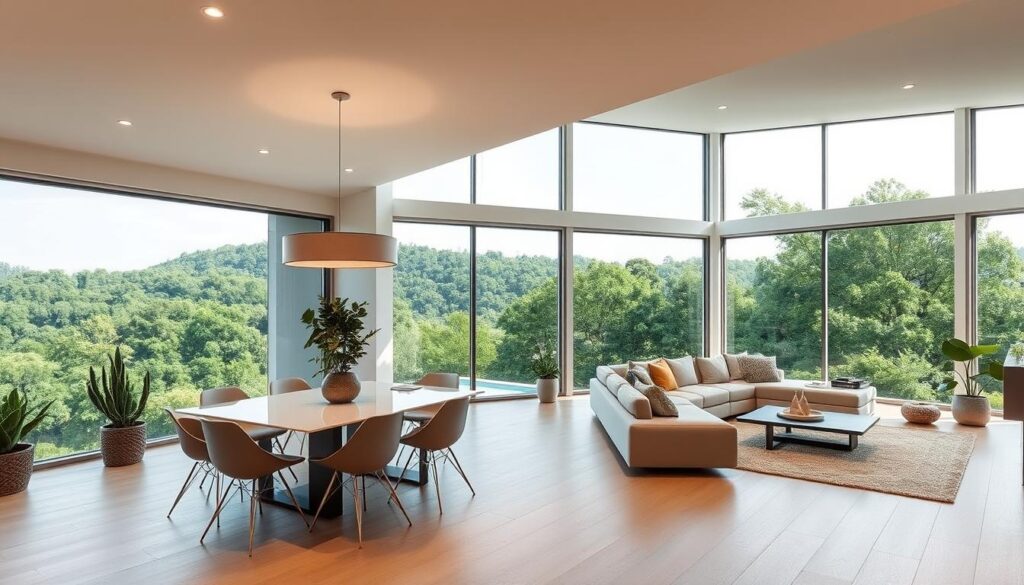
Open-concept living spaces are changing how we see the lines between living and dining areas. They make our homes more open and social. This design trend is not just about looks; it’s about building a sense of community at home.
Benefits of an Open Layout
One big plus of an open-concept living and dining room is how it makes the space feel bigger. Without walls, the area feels more open and light. It also makes it easier for family and guests to talk and move around.
Enhanced natural light is another big plus. Without walls, sunlight can flow better. Plus, an open layout can make your home look more modern and appealing to others if you decide to sell.
Tips for Seamless Decor Integration
To make an open-concept space look good together, pick a unified color palette. Choose a few main colors and use them everywhere. This creates a harmonious look.
Another tip is to have consistent flooring across the open area. This connects the different parts visually. Also, use area rugs to mark off the living and dining areas. They add warmth and texture.
- Use a unified color scheme to tie the space together.
- Select consistent flooring to create continuity.
- Employ area rugs to define different zones within the open space.
3. Rustic Charm: Wood and Natural Elements
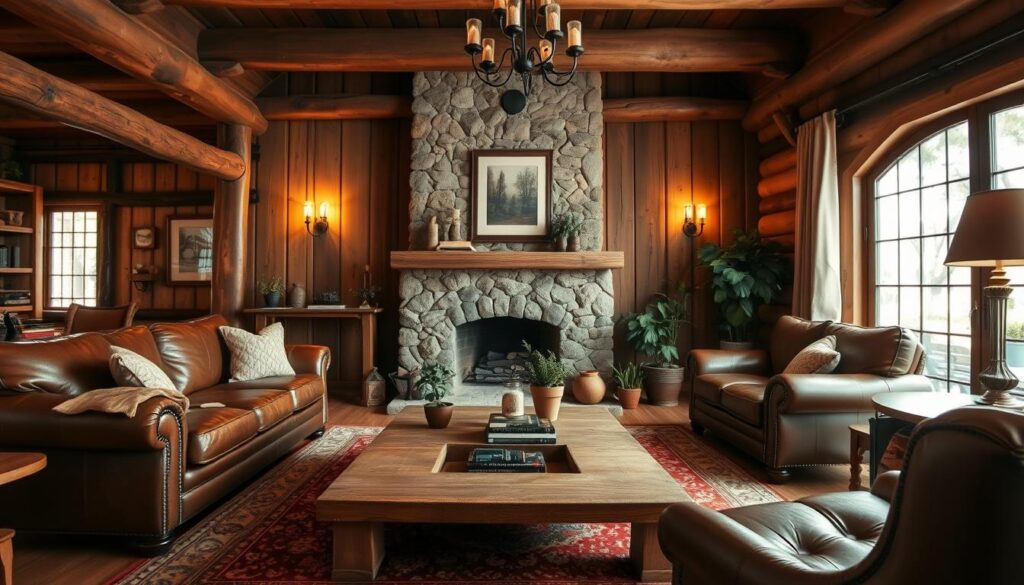
Rustic charm is back in home decor, bringing warmth and coziness. It’s all about natural materials and textures for inviting spaces.
Wooden furniture is key for rustic charm. Pieces like reclaimed wood tables or wooden benches warm up the room. Wooden furniture with a distressed finish adds to the rustic look.
Incorporating Wooden Furniture
When adding wooden furniture, keep these tips in mind:
- Go for solid wood over engineered wood.
- Choose furniture with a natural finish for more rustic charm.
- Add wooden decorative items like wall art or ceiling beams.
Decorative accents from natural materials also boost the rustic charm of your spaces.
Decorative Accents with Natural Materials
Here are some ideas for decorative accents:
- Use natural fibers like jute or sisal for rugs.
- Add natural elements like pinecones, branches, or stones to your decor.
- Bring in greenery with plants or a vase of fresh flowers.
Wooden furniture and natural decorative accents make your living and dining areas warm and inviting. This trend celebrates the beauty of natural materials and textures, creating a cozy home.
4. Modern Minimalism in Living Room Design
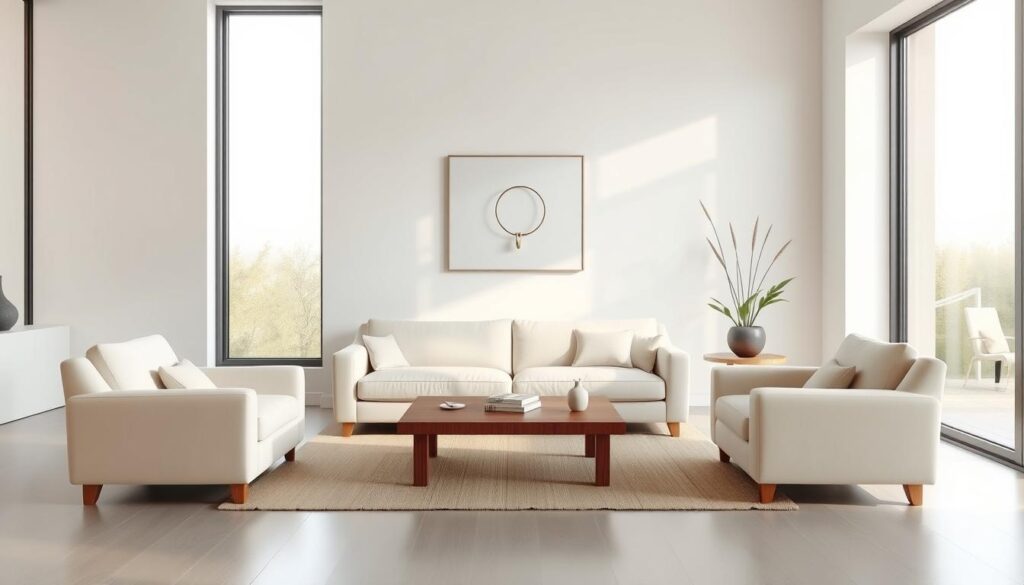
The modern minimalist living room design focuses on clean lines and minimal decoration. It’s great for small spaces because it makes them look bigger. It also keeps the area tidy.
Key Features of Minimalist Style
Minimalist living rooms are simple yet elegant. They have:
- Neutral color palettes
- Clean lines and minimal ornamentation
- Functional furniture with simple designs
- Ample natural light
- Clutter-free spaces
To get a minimalist look, focus on the basics. Choose furniture with clean lines and simple patterns. Stick to a neutral color scheme.
Choosing Functional Furniture
Functional furniture is key in minimalist design. Look for pieces that do more than one thing, like a storage ottoman or a coffee table with storage. This cuts down on clutter and makes the room more useful.
| Furniture Piece | Minimalist Features | Benefits |
|---|---|---|
| Sofa | Simple design, neutral color | Creates a clean look, easy to maintain |
| Coffee Table | Minimal ornamentation, storage | Reduces clutter, functional |
| Armchair | Clean lines, simple upholstery | Comfortable, aesthetically pleasing |
By using these elements, you can make a modern minimalist living room that’s both stylish and practical. For small spaces, check out modern dining room decor ideas and small space dining room solutions that are simple and useful.
5. Comfortable and Functional Seating Arrangements
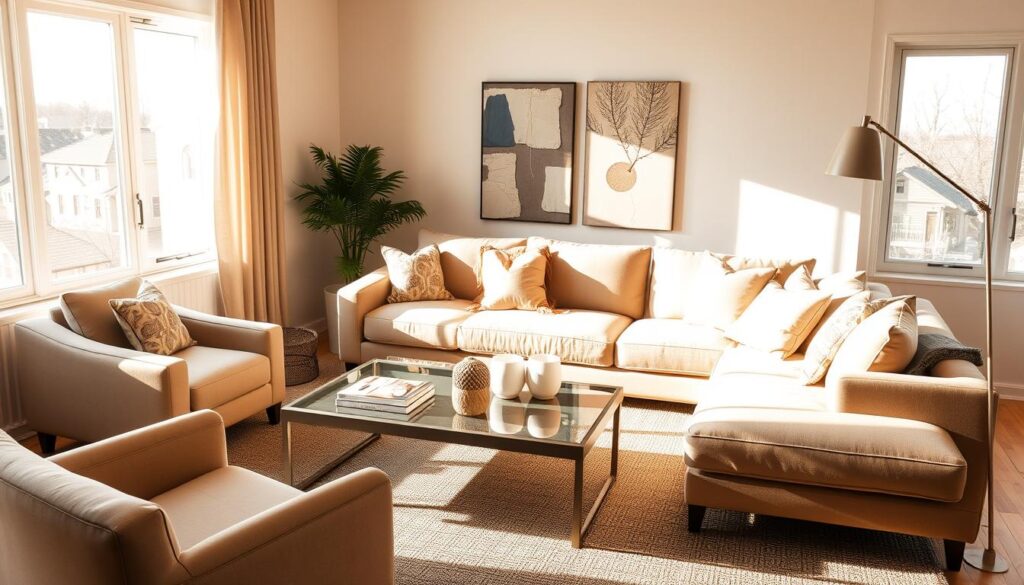
The right seating can make your living and dining areas welcoming. They’re great for both relaxing and having fun. It’s key to think about both comfort and how well they work.
Sectional Sofas vs. Traditional Sofas
Sectional sofas are loved for their flexibility and coziness. They can be set up to match your room’s shape, offering lots of room for everyone.
Benefits of Sectional Sofas:
- Customizable configurations to fit any room shape
- Enhanced seating capacity
- Can include additional features like recliners or sleeper sections
Traditional sofas, however, bring a timeless charm. They’re easy to blend into your decor. Your choice depends on what you need and your room’s style.
Dining Bench vs. Chairs
In dining areas, benches and chairs have different effects. Benches create a snug, friendly vibe and save space. They’re perfect for smaller rooms where chairs might be too big.
Advantages of Dining Benches:
- Space-saving design
- Encourages a sense of togetherness
- Can be paired with chairs for a mixed seating arrangement
But chairs give more room and are comfy for long meals. Your choice should reflect your dining style and desired atmosphere.
6. Statement Lighting Ideas for Dual Spaces
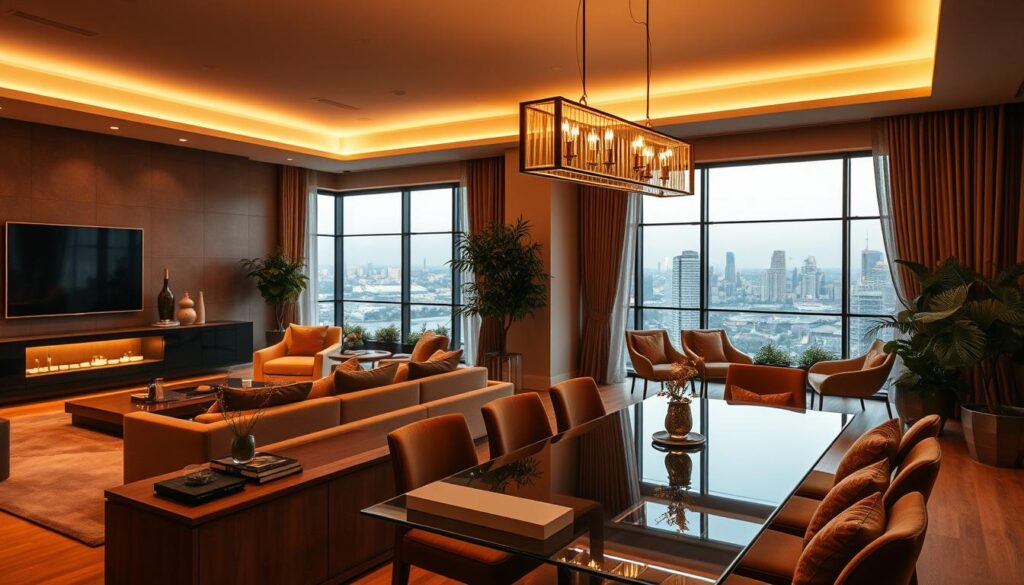
Statement lighting can make dual spaces more inviting. In a stylish living room and dining room combo, lighting is both functional and decorative. It ties the whole space together.
When designing a dual space, think about different lighting options. Pendant lights and chandeliers add elegance.
Pendant Lights vs. Chandeliers
Pendant lights are versatile and fit many decor styles. They offer focused lighting and can be hung at various heights for a unique look.
Chandeliers, however, are dramatic and sophisticated. They’re great in dining areas, creating a warm atmosphere.
Creative Floor Lamps for Ambiance
Floor lamps add ambiance to dual spaces. They’re perfect for cozy reading nooks or extra lighting where overhead lights don’t reach.
Choose floor lamps that match your furniture’s style and size. Creative designs can also be decorative, enhancing the room’s look.
In conclusion, statement lighting is key in a stylish living room and dining room combo. Use pendant lights, chandeliers, and creative floor lamps. This way, you create a beautiful, inviting space that shows off your style.
7. Multi-Functional Furniture for Small Spaces
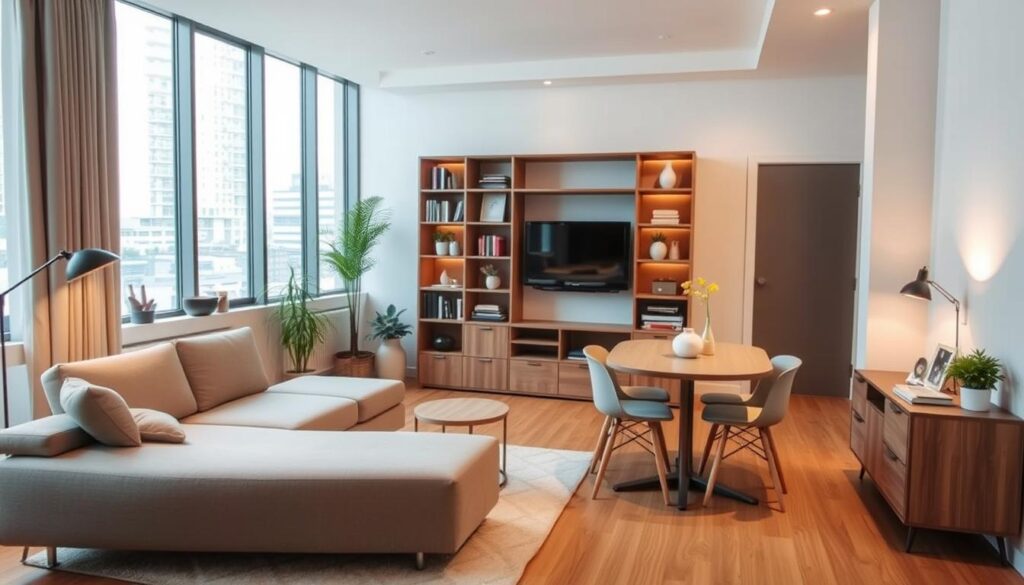
Maximizing space with multi-functional furniture is a game-changer for compact homes. In small living and dining areas, the right furniture can significantly enhance both functionality and aesthetics.
As small space dining room solutions become increasingly important, homeowners are turning to innovative furniture designs that serve multiple purposes. One of the most effective ways to optimize space is by incorporating furniture that can adapt to different needs.
Sofa Beds: Comfort Meets Convenience
Sofa beds are a quintessential example of multi-functional furniture. They provide a comfortable seating area during the day and convert into a bed at night, making them ideal for small homes where space is at a premium.
“Sofa beds have revolutionized the way we think about living spaces,” says interior design expert, Jane Smith. “They offer the perfect blend of comfort and practicality.”
“The versatility of sofa beds makes them an essential component in modern small-space design.”
Foldable Dining Tables for Easy Storage
Another excellent example of multi-functional furniture is the foldable dining table. These tables can be easily set up when needed and folded away, providing more floor space when not in use.
When choosing foldable dining tables, consider the material and durability to ensure they withstand regular use. A well-designed foldable table can be a minimalist dining room decor solution that adds to the room’s aesthetic.
By incorporating such multi-functional pieces, homeowners can create a more spacious and flexible living environment. Whether it’s a sofa bed or a foldable dining table, these furniture solutions are designed to make the most of the available space.
8. Incorporating Greenery in Living and Dining Rooms
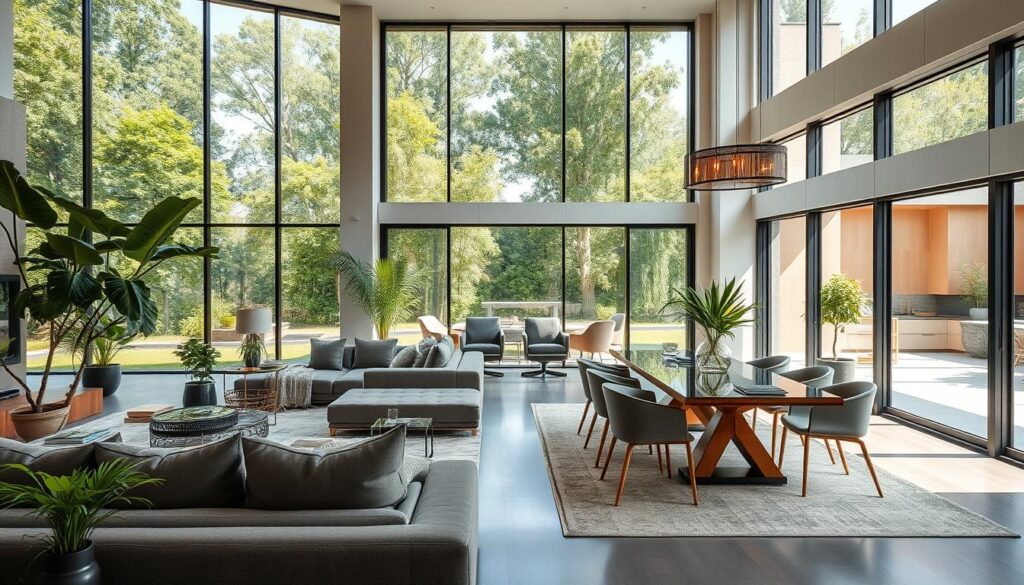
Greenery is more than just a decoration. It brings life to your home’s living and dining rooms. Indoor plants purify the air and add a natural touch. This enhances your home’s look, fitting with modern dining room decor ideas and luxury living room design trends.
The Benefits of Indoor Plants
Indoor plants offer many benefits. They improve air quality and reduce stress. They also add color and texture, making spaces feel lively and welcoming.
- Enhance aesthetic appeal
- Improve air quality
- Reduce stress levels
Stylish Planters and Displays
The right planter can make your indoor plants stand out. Choose planters that match your home’s style. Whether it’s modern, rustic, or eclectic, there’s a planter for you.
| Planter Style | Description | Best For |
|---|---|---|
| Modern | Sleek, minimalist designs | Contemporary homes |
| Rustic | Earthy, natural materials | Countryside or farmhouse styles |
| Eclectic | Unique, artistic designs | Homes with a mix of styles |
Choosing and placing indoor plants and their planters thoughtfully creates a welcoming atmosphere. It captures the essence of luxury living room design trends perfectly.
9. Mixing Different Design Styles
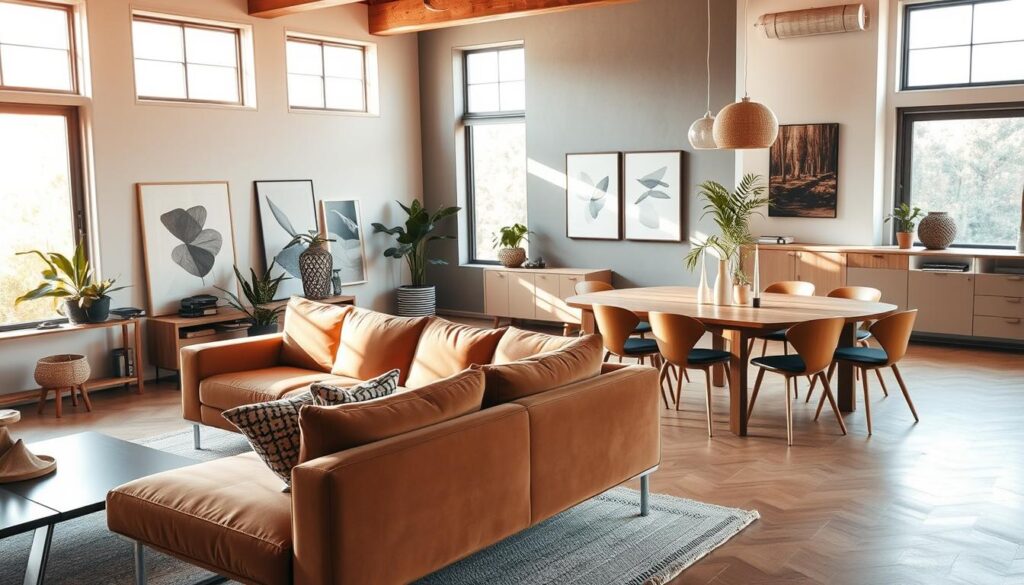
Mixing styles in your living and dining areas can make your space welcoming. It lets you show your personality and make a space that’s truly yours.
Eclectic Design: Finding Harmony
Eclectic design mixes different styles and textures for a unique look. A key to harmony is a contemporary living room furniture set that ties everything together.
Remember the 60-30-10 rule: 60% of the room should be one style, 30% another, and 10% an accent. This balance makes your space look good and feel right.
Transitional Spaces Between Styles
Transitional spaces are where different styles meet. Use things like area rugs or console tables to connect different styles smoothly.
For instance, a modern living room and a traditional dining area can be connected by a contemporary rug. This rug ties both areas together nicely.
By carefully mixing styles, you can make a stylish living room and dining room combo. It will be both beautiful and useful.
10. Textiles and Fabrics to Enhance Aesthetics
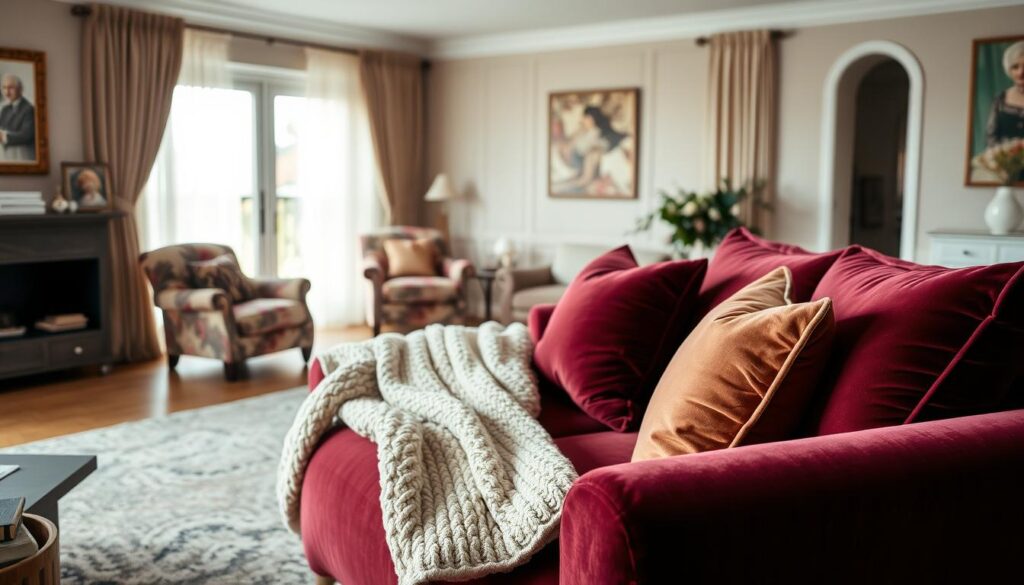
The right textiles and fabrics can really make living and dining areas look better. They add color and texture. They also help set the mood of a space.
Choosing the Right Curtains
Curtains do more than just look good; they change how a room feels. Choosing the right curtains means thinking about the fabric, color, and length. Sheer curtains brighten a room, while thick ones add luxury and warmth.
It’s key to match curtains with your room’s style. For a minimalist dining room decor, go for simple designs. An elegant room might need more detailed patterns and rich fabrics.
Area Rugs for Defined Spaces
Area rugs are great for making living and dining areas look better. They can mark off different areas in an open-plan room. They add warmth and texture to the floor. Area rugs are made from many materials, like wool or synthetic fibers, fitting all styles.
When picking an area rug, think about its color and texture with your furniture and decor. A rug that matches your elegant dining room furniture ideas can make the space feel welcoming and unified.
| Textile/Fabric | Purpose | Style Impact |
|---|---|---|
| Curtains | Control Light, Add Color | Can make a room appear larger or cozier |
| Area Rugs | Define Spaces, Add Warmth | Can tie together different furniture pieces |
| Upholstery Fabric | Cover Furniture | Can greatly influence the room’s overall aesthetic |
11. Innovative Dining Table Shapes and Sizes
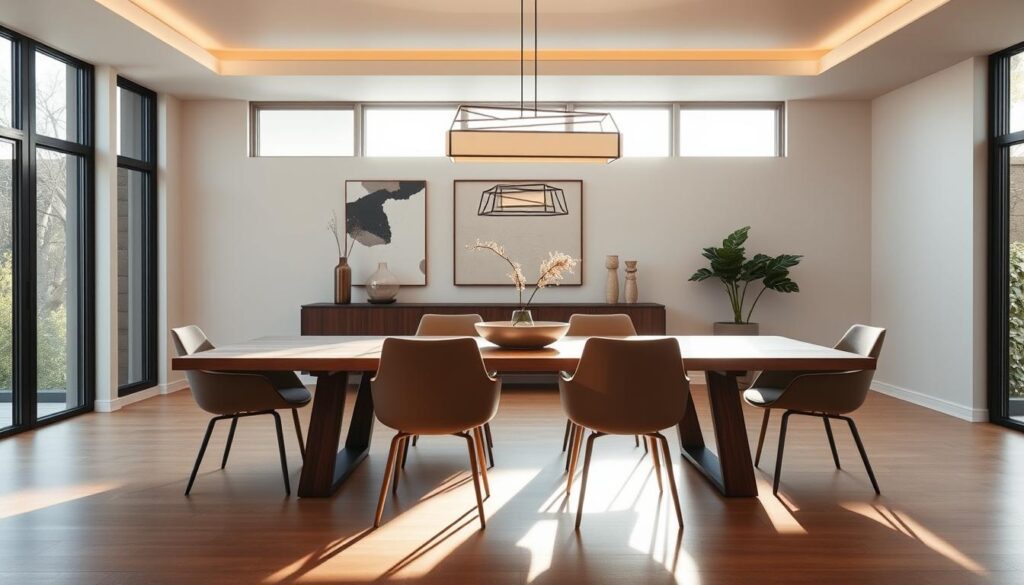
The dining table is the heart of any dining area. Its shape and size are key to defining the space. Whether you have a small apartment or a big dining room, the right table makes a big difference.
When choosing a dining table, the debate is often round versus rectangular. Round tables are great for small spaces. They create a cozy, intimate setting and make conversation easy. They fit well in corners and take up less visual space.
Rectangular tables are more traditional. They can seat more people, perfect for big families or when you entertain often. They’re also versatile, fitting well against walls or in the room’s center.
Round vs. Rectangular Tables
The choice between round and rectangular tables depends on your dining area’s needs. For example, a long, narrow room might do better with a rectangular table. It fits along the room’s length, saving space.
Extending Tables for Flexibility
Extending tables are a smart choice for dining tables. They adjust their size for different occasions. This makes them ideal for modern dining rooms.
Extending tables come in many shapes and sizes. They’re great for small spaces that need to change. They expand for big events and shrink for everyday meals, offering a smooth dining experience.
In conclusion, choose your dining table based on your dining area’s size and your preferences. Think about the room’s layout, how many people you’ll have, and the mood you want. This way, you’ll find a table that looks good and works well.
12. Personalizing Your Living Room and Dining Area
Adding personal touches to your living room and dining area is key. It makes your space feel welcoming and unique. This aligns with the latest luxury living room design trends.
Adding Personal Touches
Family photos, artwork, and heirlooms are great for adding a personal touch. They bring warmth and create a sense of history. This makes your space feel more connected.
Customizable Decor
Customizable decor, like monogrammed throw pillows or bespoke furniture, adds a personal feel. It blends functionality with personal expression. This makes your living and dining areas truly unique.
By adding these personal touches, you create a cohesive and inviting atmosphere. It reflects your taste and style, making your home a perfect blend of luxury and comfort.

